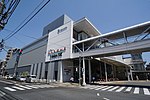Katsusaka Site
Historic Sites of JapanHistory of Kanagawa PrefectureJōmon-period ruinsSagamihara

The Katsusaka Site (勝坂遺跡, Katsusaka iseki) is an archaeological site containing the ruins of a large Jōmon period settlement located in what is now the Isobe neighborhood of Minami-ku, Sagamihara, Kanagawa Prefecture in the southern Kantō region of Japan. The site was designated a National Historic Site of Japan in 1974, with the area designated expanded in 1980, 1984, 2006 and 2019. The site was first discovered by Kashiwa Oyama (the son of General Oyama Iwao) in 1926.
Excerpt from the Wikipedia article Katsusaka Site (License: CC BY-SA 3.0, Authors, Images).Katsusaka Site
神奈川県道46号相模原茅ヶ崎線, Sagamihara Minami Ward
Geographical coordinates (GPS) Address Nearby Places Show on map
Geographical coordinates (GPS)
| Latitude | Longitude |
|---|---|
| N 35.508888888889 ° | E 139.38833333333 ° |
Address
勝坂遺跡公園
神奈川県道46号相模原茅ヶ崎線
252-0335 Sagamihara, Minami Ward
Japan
Open on Google Maps









